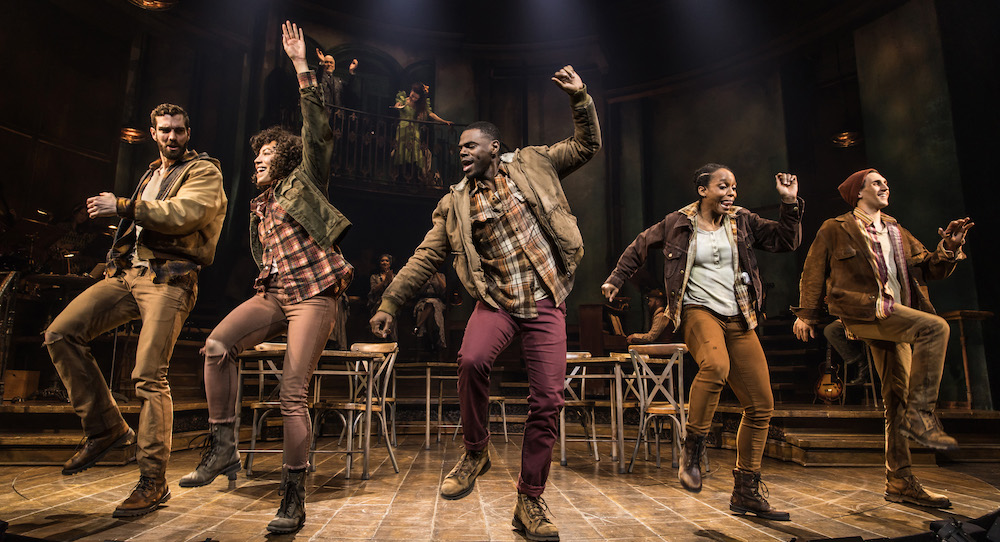Hadestown is the musical I had unknowingly been waiting for all season. While the title might not ring a bell like those of more commercial shows such as Tootsie, The Cher Show and The Prom, there’s something oddly familiar about Hadestown.
The musical is an inventive retelling of a Greek myth…set during the Great Depression with a jazzy New Orleans-style flair. The myth, although not familiar to me, was easy to follow. Hades and Persephone, the goddess of the harvest and fertility, are married. Persephone spends half the year on Earth (spring and summer) and the other half with Hades in the Underworld (making the Earth suffer fall and winter). Orpheus, a struggling songwriter, falls in love with Eurydice. When Persephone goes to the underworld and winter comes, Orpheus is too distracted with his songwriting to care for Eurydice. So, she ventures to the Underworld and sells her soul to Hades so that she would have food and warmth. But the Underworld is no paradise, and Eurydice soon realizes her laborious, imprisoned life ahead. Orpheus ventures to the Underworld to rescue her, and he softens Hades’ heart with his (finally) finished song. Hades compromises: Eurydice can leave on one condition — when Orpheus leads the way back home, he cannot turn back to look and see if Eurydice is following him or she will be lost to him forever…
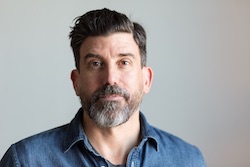
David Neumann. Photo by Maria Baranova.
The storytelling is fresh, the music is infectious, the design is stunning, and the choreography further infuses Hadestown with life and meaning. Dance Informa got the opportunity to chat with choreographer David Neumann, just days after hearing his Tony nomination for the show and before he received the Chita Award for Best Choreography, on his Broadway debut.
You’ve been with Hadestown since its first realization in 2010. How has the choreography changed since that first workshop?
“Well, most significantly, we added an ensemble. I tend to work very closely and individually with the actors, and the piece has evolved throughout our journey. There are two main focuses for me as a choreographer. One, of course, is the story. In a piece like this, I see it more as an epic poem than a traditional piece of musical theater. I want to support its unique artistic form, the needs of the story, and the development of and investment in the characters. And my second focus is the music. This score really makes you want to move, and I wanted to embrace that.”
How did you become involved with the project?
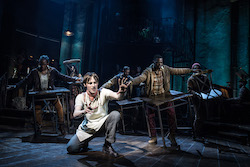
Reeve Carney and the Broadway cast of ‘Hadestown’. Photo by Matthew Murphy.
“Hadestown was initially a concept album. But when the piece was in talks to be put into a theater-setting, I was brought on to help create some initial staging, and I’ve been with the project ever since!”
So now, nearly 10 years later, the show is frozen on Broadway. Do you feel relief, or are you going to miss continuing to work and develop the show?
“It’s bittersweet. Hadestown is one of those pieces where the more you dig, the more you find. Still, it feels good to have a version that exists and is fully-fleshed out. What’s most gratifying is that, when I come back to see the show again and again, I am still moved by it, and audiences are moved by it, too.”
Hadestown blends so many different worlds — Greek mythology, New Orleans jazz, modern political commentary and the American dream. How did you explore these worlds through the choreography?
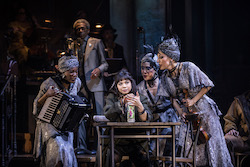
Eva Noblezada and the Broadway cast of ‘Hadestown’. Photo by Matthew Murphy.
“I did a lot of research surrounding Greek myths, sculpture and paintings. I explored the gumbo of cultures in New Orleans, because, if this was truly going to be an American story, we had to reflect the cultures that were used and enslaved to make this country the economic powerhouse that it has become. Some of my background is in b-boying, club dance, breakdance, West African dance and traditional dances from a lot of different countries. With all this research, I then turned pretty quickly to the immediate demands of the show — what the story and music were saying to me. Collaborating with Rachel, our director, was also imperative so that we connected as a team. And then, meeting and working with the actors themselves brought a new level of exploration. I also believed that the ensemble should not just be a machine or a conduit for precision. You really see the individual mind and effort in each dancer as they organically come into their own.”
Did you feel like you had to mold the work in a different way once you knew you were coming to Broadway?
“Our focus was always to embody the music and story in a way that connects with audiences. I come from a downtown experimental dance and theater world, so I’m willing to take a lot of risks on stage. And I think that serves Hadestown — never being afraid to ask, ‘What if…?’ No matter what stage we were performing on, our goal was for the show to seem as inspired as its source material.”
The principal actors each have their own stylized vocabulary of movement. Even if the show didn’t have words, you could understand their characters through their movement. How did this choreography evolve?
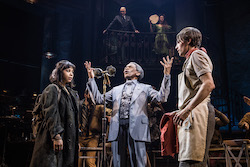
Eva Noblezada, Andre De Shields and Reeve Carney in ‘Hadestown’. Photo by Matthew Murphy.
“I love to work very personally with each actor, and we have some spectacularly seasoned actors in this show. As a choreographer, I would give direction that would eventually become an exploration and conversation until we find — together — what worked. In this way, the actors can really own their movement because it is organic to themselves as individuals.”
Props are also choreographed in Hadestown. Can you talk to us about the scene with the lamps during ‘Wait for Me’?
“This came from an image of streetlights going by. We tried a lot of things but found that the purist movement (of just holding and letting the lamps go) was the most powerful. And even though it looks simple, the scene was carefully constructed so no one in the audience or the orchestra gets hit!”
For more information or to purchase tickets to Hadestown, visit www.hadestown.com.
By Mary Callahan of Dance Informa.


